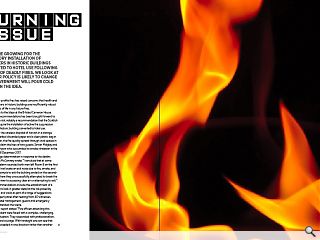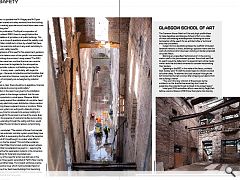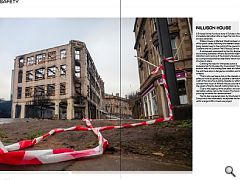Fire Safety: Burning Issue
17 Apr 2023
Calls are growing for the mandatory installation of sprinklers in historic buildings converted to hotel use following a series of deadly fires. We look at whether policy is likely to change or if government will pour cold water on the idea.
A spate of high-profile fires has raised concerns that health and safety precautions in historic buildings are insufficiently robust to minimise loss of life in any future fires.
In response to the blaze at the B-listed Cameron House Hotel, a raft of recommendations has been brought forward to minimise future risk; notably a recommendation that the Scottish Government require the installation of active fire suppression systems in any historic building converted to hotel use.
Initiated by the careless disposal of hot ash in a storage closet, which ignited discarded paper and a clear plastic bag in a large metal bin, the fire quickly spread through void spaces in the building to claim the lives of two guests; Simon Midgley and Richard John Dyson who succumbed to smoke inhalation in the early hours of 18 December 2017.
In a 122-page determination in response to the deaths Sheriff Thomas McCartney wrote: “I conclude that at some point after the alarm sounded both men left Room 8 on the first floor and could not locate an exit route due to fire, smoke, and gases. Their attempts to exit the building ended on the second-floor landing where they unsuccessfully attempted to break the window with a view to accessing clear air or attempting to exit.”
Other recommendations include the establishment of a working group to look in greater detail at the risk posed by hidden cavities and voids as part of a range of suggestions made by an expert panel after hearing from 40 witnesses, including the hotel management, guests and emergency services who attended the scene.
The Crown report stated: “Fire officers attending this emergency incident were faced with a complex, challenging, and dynamic situation. They responded with professionalism, commitment, and courage. With hindsight one can see that had officers proceeded in one direction rather than another at various points it is possible that Mr Midgley and Mr Dyson could have been located and safely removed from the building. However, that is entirely speculative and would have been more luck than anything else.”
Following its publication, The Royal Incorporation of Architects in Scotland (RIAS) threw its weight behind the retroactive installation of sprinklers in all public buildings. This stance throws up a range of questions around the viability, cost and efficacy of later installs but is driven by a belief that these difficulties can be overcome and are in any event secondary to the potential public safety benefits.
Taking cognisance of the need for fire assessment guidance to be expanded to take account of the specific risks associated with historic buildings the architect’s body stated: “The RIAS believes sprinklers save lives, and that the time has come for the Scottish Government to legislate for the retrospective installation of sprinkler systems in all buildings used by the general public. In many cases – particularly with regard to historic buildings – there are complexities and technicalities that may need to be overcome. However, we agree with the Sheriff that any issues of complexity are outweighed by potential safety benefits.”
“Our position is clear: there should be no legislative, financial or technical obstacles to ensuring public safety.”
Consideration in the report was given to the installation of a sprinkler system in the storage cupboard, but this was dismissed as impractical in a small space. Moreover, British Standards expressly exempt the installation of a sprinkler head in an area housing electrical power distribution. Advice centres instead on placing these in adjacent rooms or corridors. While a fire suppression system can extinguish a blaze its primary purpose is to buy time for occupants to escape, holding it in check long enough for fire services to arrive at the scene. Even then, however, the presence of voids and cavities surrounding the cupboard, extending through the ceiling and floor, would still have permitted fire and smoke to spread, compromising escape routes.
The report concluded: “The opinion of Group Commander Marshall is that an automatic sprinkler system would likely have had a positive effect in suppressing the fire within the reception area for a period of time although it is unclear what effect it may have had on the fire spread.”
This and other evidence convinced architect Peter Drummond, another expert witness, to recommend that consideration be given to ‘... requiring the installation of active fire suppression systems in the conversion of historic buildings for hotel and associated uses.’
The urgency of the need for action was laid bare in the New Year, when three guests were killed at Perth’s New County Hotel following another blaze. This incident reinforces a sense of urgency around an issue which must be tackled head-on to prevent some of our best-loved buildings from becoming ticking time bombs. The inevitability of future incidents makes the need for action all the more acute.
|
|





